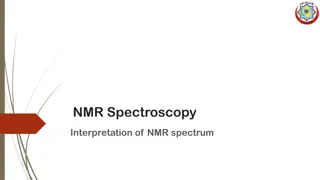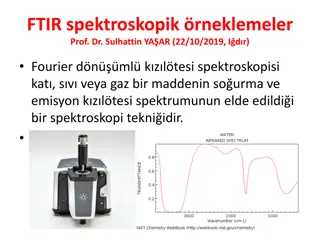Understanding Molecular Vibrations and Infrared Spectroscopy in Chemistry
Molecular vibrations play a crucial role in the study of chemical compounds through infrared spectroscopy, where different modes such as stretching and bending of bonds are analyzed based on their energy levels. Infrared absorption leads to changes in dipole moments, affecting the reactivity of molecules. This article delves into the fundamentals of vibrational modes and their significance in analytical chemistry.
Download Presentation

Please find below an Image/Link to download the presentation.
The content on the website is provided AS IS for your information and personal use only. It may not be sold, licensed, or shared on other websites without obtaining consent from the author. Download presentation by click this link. If you encounter any issues during the download, it is possible that the publisher has removed the file from their server.
E N D
Presentation Transcript
INFRA-RED SPECTROSCOPY 4 Introduction 2023-2024
Near-infrared; 140004000 cm1(0.82.5 m wavelength) can excite overtone or harmonic vibrations. Mid-infrared; 4000 400 cm 1(2.5 25 m) may be used to study the fundamental vibrations and associated rotational- vibrational structure. Far-infrared, 400 10 cm 1(25 1000 m), lying adjacent to the microwave region, has low energy and may be used for rotational spectroscopy.
What happens when a sample absorbs UV/Vis energy? * UV/Vis Excitation of ground state electrons (typically and n electrons) increases momentarily * transition sample Eelectronic ( 200 nm) What happens when a sample absorbs IR energy? Stretching and bending of bonds (typically covalent bonds) momentarily IR -O-H -O H Evibration increases ( 3500 cm-1) (IR) measures the bond vibration frequencies in a molecule and is used to determine the functional group
MOLECULAR VIBRATIONS What is a vibration in a molecule? Any change in shape of the molecule- stretching of bonds, bending of bonds, or internal rotation around single bonds There are two main vibrational modes : 1. Stretching - change in bond length (higher frequency) Occurs at higher energy: 4000-1250 cm-1 Asymmetric Symmetric
2. Bending - change in bond angle (lower frequency) Occurs at lower energy: 1400-666 cm-1. In-plane (Scissoring) Out-plane (Twisting) More complex types of stretching and bending vibrations are possible
Scissoring Symmetric stretching Asymmetric stretching Wagging Twisting Rocking Dipole moments occur when there is a separation of charge. They can occur between two ions in an ionic bond or between atoms in a covalent bond; dipole moments arise from differences in electronegativity. The larger the difference in electronegativity, the larger the dipole moment.
Can a vibration change the dipole moment of a molecule? Infrared active vibrations (those that absorb IR radiation) must result in a change of dipole moment Asymmetrical stretching/bending are IR active. Symmetrical stretching/bending is not IR active Question: Which of the following atoms or molecules will absorb IR radiation and WHY?: H2 N2 Cl2 I Cl
Number of vibrational modes A molecule can vibrate in many ways, and each way is called a vibrational mode. In order for a vibrational mode in a sample to be "IR active", it must be associated with changes in the dipole moment. Example H2O, will have (3 3 6 = 3) degrees of vibrational freedom, or modes. For molecules with N number of atoms, 1. Linear molecules have 3N 5 degrees of vibrational modes 2. Nonlinear molecules have 3N 6 degrees of vibrational modes (also called vibrational degrees of freedom). Symmetric Bending Asymmetric
Factors affect the NUMBER of IR bands 1) Degeneracy of bands from several absorptions of the same frequency 2) Lack of change in molecular dipole moment during vibration 3) Fall of frequencies outside the 4000-400 cm-1 region All of above factors decrease the number of bands What are the reasons that affect (reduced or increase) the number of theoretical fundamental vibrations in IR spectroscopy?
HOOKES LAW Bonds can be thought like a spring, and wavenumbers can be approximated by Hooke s law The electronegativity (force constant of the bond) a) The relative masses of the atoms b) Their geometry vibrate at different types c) 1 2 1 k = M M 2 c x y = + M M x y
Hookes law-Example Calculate the predicted vibrational frequency (in cm-1) for C- H bond, knowing that: The force constant for single bond is 5x 105 dyne/ cm, the velocity of light is 3 X 108 cm/s, the mass of carbon atom is 20 x10-24g, the mass of hydrogen is 1.6 x 10-24 g. 1 2 1 k = 2 c
The relationship between wave number (v), bond strength and mass The vibrational frequency of a bond would increase with the increase in bond strength. Consequently, we can expect that C=C and C=O > C-C and C-O, respectively The vibrational frequency of a bond would increase with the decrease in reduced mass of the system. C-H and O-H > C-C and C-O, respectively Similarly, O-H > O-D
Instrumentation IR spectroscopy source of energy Sampling area Photometer Grating (monochromator ) Detector
Solvents in IR spectroscopy Properties of solvents 1. Pure solvent is placed in the reference 2. The spectrum thus obtained is that of the solute except in the region in which the solvent absorbs strongly . 3. The solvent selected must be dry and transparent in interest . Types of solvents Solvent, like carbon tetrachloride (CCl4) a is relatively free of absorption at frequencies above 1333 cm -1 , carbon disulfide (CS2) shows little absorption below 1333cm-1 Solvent and solute combinations that react must be avoided . For example :- 1. CS2 cannot be use as a solvent for primary or secondary amine 2. Amino alcohol react slowly with CS2 & CCl4 Chloroform (CHCl3) shows absorption at all wavelength but its absorption is so high ,so avoid it and used analyses dissolving solvent than neglected
Factors affect IR frequencies The replacement of an alkyl group of the saturated aliphatic ketone by a heteroatom (O, N) shifts the C=O stretching frequencies due to inductive and resonance effects. In esters, the oxygen due to inductive effect withdraws the electrons from carbonyl group and increases the C=O bond strength and thus the frequency of absorption. Inductive and Resonance Effects Conjugation Effects Ring size effects Hydrogen bonding
Factors affect IR frequencies In amides, due to the conjugation of lone pair of electrons on nitrogen atom, the resonance effect increases the C=O bond length and reduces the C=O absorption frequency. Therefore, C=O absorption frequencies due to resonance effects in amides are lowered but due to inductive effect in esters are increased than those observed in ketones. Inductive and Resonance Effects Conjugation Effects Ring size effects Hydrogen bonding What is the effect of inductive and resonance effect at the at Vibration frequencies?
Factors affect IR frequencies In acid chlorides, the halogen atom strengthens the C=O bond through inductive effect and shifts the C=O stretching frequencies even higher than are found in esters. Inductive and Resonance Effects Conjugation Effects The acid anhydrides give two bands in C=O stretching frequency region due to symmetric (~1820 cm-1) and asymmetric (~1760 cm- Ring size effects 1) stretching vibrations. Hydrogen bonding What is the effect of inductive and resonance effect at the at Vibration frequencies?
Factors affect IR frequencies The C=O stretching frequencies for C=C conjugated systems are generally lower by 25-45 cm-1 than those of corresponding non- conjugated compounds. The delocalization of -electrons in the C=O and C=C bonds lead to partial double bond character in C=O and C=C bonds and lowers the force constant. Greater is the ability of delocalization of electrons, the more is lowering in C=O stretching frequency. Inductive and Resonance Effects Conjugation Effects Ring size effects Hydrogen bonding
Factors affect IR frequencies Decrease in ring size increases the C=O stretching frequency. This gives more s character to the C=O sigma bond and thus results in strengthening of C=O double bond. The comparison of C=O stretching frequencies of various compounds shows that in ketones and esters, ~ 30 cm-1 increase in frequency occurs on moving to one carbon lower ring. Inductive and Resonance Effects Conjugation Effects Ring size effects Hydrogen bonding
Factors affect IR frequencies The strength of Hydrogen bonding decreases as the distance between X & Y increase. Hydrogen bonding alters the force constant of both groups ,thus, the frequencies of both stretching and bending vibrations are altered The X-H stretching band move to lower frequencies (longer wavelength )usually with increase intensity and band widening The stretching frequency of the acceptor group ,for , C=O is also reduced but to a lesser degree than the proton donor group Inductive and Resonance Effects Conjugation Effects Ring size effects Hydrogen bonding
Factors affect hydrogen bonding A. Temperature since when temp. increases, the H- bonding decreases B. Concertation have different affect on both H-bonding result from intermolecular bonding disappear at low conc. While intramolecular bonding has internal effect & so it persist at very low conc. C. The relative acidity and basicity of the proton donor and acceptor groups affect the strength of bonding. D. Ring strain E. Molecular geometry
Factors affect position of C=O stretching band A. The physical state B. Electronic and mass effect of neighbouring group C. The relative acidity and basicity of the proton donor and acceptor groups affect the strength of bonding. D. Ring strain E. Conjugation effect F. Hydrogen bonding effect G. Inductive effect
Example: The carbonyl stretching frequency in RCOCH3 (~1720 cm-1) is lower than acid chloride RCOCl (1750-1820 cm-1). This change in frequency of the C=O stretching may be arising due to: a. Difference in mass between CH3 and Cl b. The inductive or mesomeric influence of Cl on the C=O bond c. Coupling interactions between C=O and C -Cl bonds d. Change in bond angles arising due to steric factors etc.























